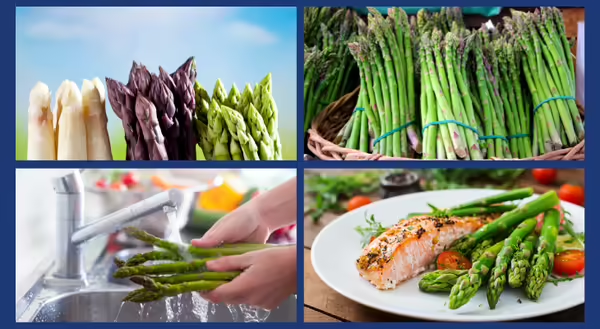
One vegetable that is notably present in grocery stores across the nation each spring is asparagus. Although asparagus can be found year-round, the peak availability of this perennial vegetable is in the spring.
This vegetable has long slender, brightly colored spears with pointy crowns. The color will vary depending on the variety of the asparagus; it can be green, purple, or white. Whatever the color, these flavorful vegetables contain key nutrients our body needs, like fiber, folate, and vitamins C and K.
Not only is asparagus nutritious, but it is also versatile. Whether you boil, broil, grill, roast, sauté, steam, or eat raw, asparagus is a tasty addition to any meal. Add to a breakfast omelet, serve them cold in a salad, or roast them with a bit of olive oil. There are many ways to season and serve asparagus; simply let your tastebuds and imagination lead the way.
Selecting Fresh Asparagus
Look for asparagus bunches that are firm, with tightly closed bunches. Check to make sure they are not wilted or limp and that the asparagus tips are firm and not mushy or damaged. Go ahead and smell the asparagus; if they have a strong order, do not purchase them.
As mentioned, the color of asparagus will vary depending on the variety. However, whatever the color, check to make sure it has not faded.
The diameter of asparagus can vary greatly, from very thin to the thickness of your finger. The diameter does not impact the tenderness of the spear. However, freshness does so closely examine bunches for signs of freshness.
Asparagus will start to lose flavor and moister as soon as it’s been harvested. Thus, it tastes best if used within the first few days of purchase; however, if you need to store them, follow these helpful tips listed below.
Storing Fresh Asparagus
Rinse asparagus under cool running water to remove any insects or dirt from stalks before preparing for storage. Trim the bottom ends, stand spears up in a glass jar with about an inch of water, cover them with a plastic bag, and place them in the refrigerator. Asparagus can be stored for up to 4 days using this method.
Note: Change the water in the jar as it gets cloudy to keep the asparagus fresh.
Asparagus are sensitive to ethylene gas produced by other types of produce as it ripens. When asparagus is stored with ethylene-producing produce, it can harden, giving it a woody or tough texture. It can also cause the spears to become yellow. Therefore, store asparagus away from apples, avocados, cantaloupe, peaches, and tomatoes.
Freezing asparagus: Fresh asparagus can be frozen. However, they should be blanched before freezing. Blanching asparagus will help preserve its color, taste, texture, and nutrition. Freezing without blanching will make your asparagus discolored, gritty, and mushy.
With spring in the air, local seasonal produce will be readily available depending on where you live and the growing conditions in your area. Fruit and vegetables are part of an overall healthy diet. Studies show they can help lower the risk of many chronic health conditions, such as diabetes, heart disease, and some types of cancer. So, aim to get at least 5-9 servings of fruits and vegetables daily. And who knows, maybe asparagus will become one of your new favorite spring vegetables!
Source:
Diane Reinhold, MPH, MS, RDN is a University of Illinois Extension, Educator, Nutrition and Wellness, serving Jo Daviess, Stephenson & Winnebago Counties.
Hyperlinks:
Freezing Your Summer Harvest. University of Illinois Extension
Roasted Asparagus. University of Illinois Extension
Fruit and vegetable consumption reduce risk of death. National Institutes of Health